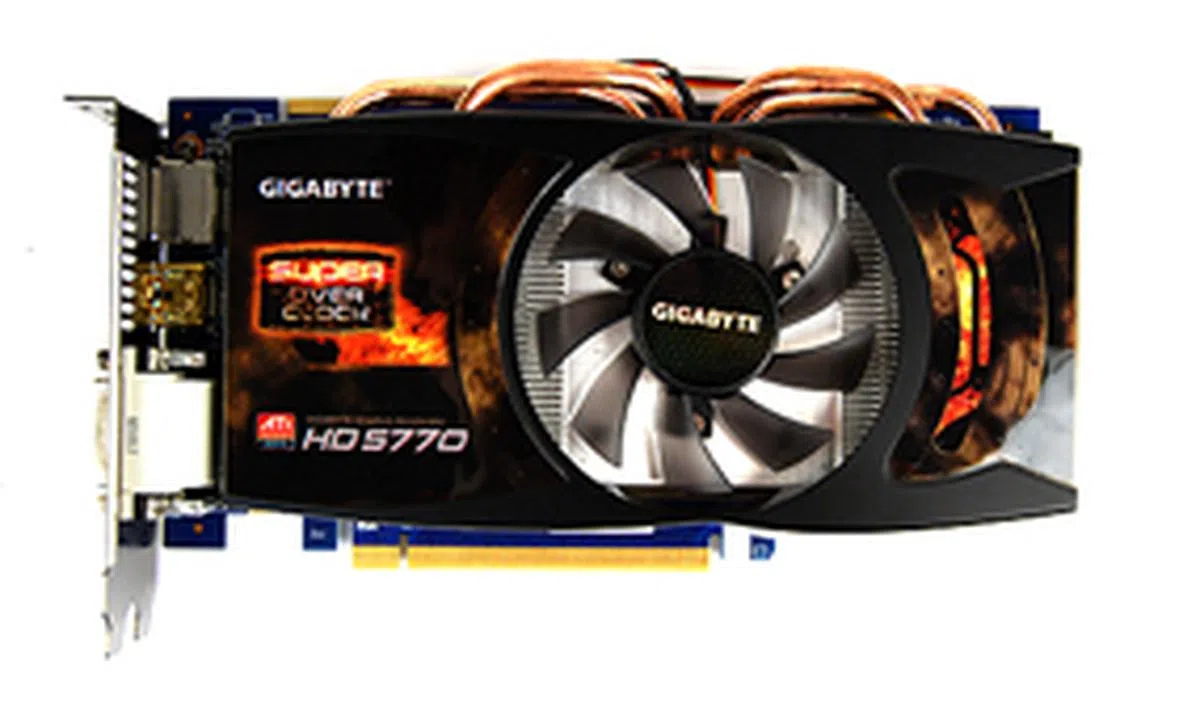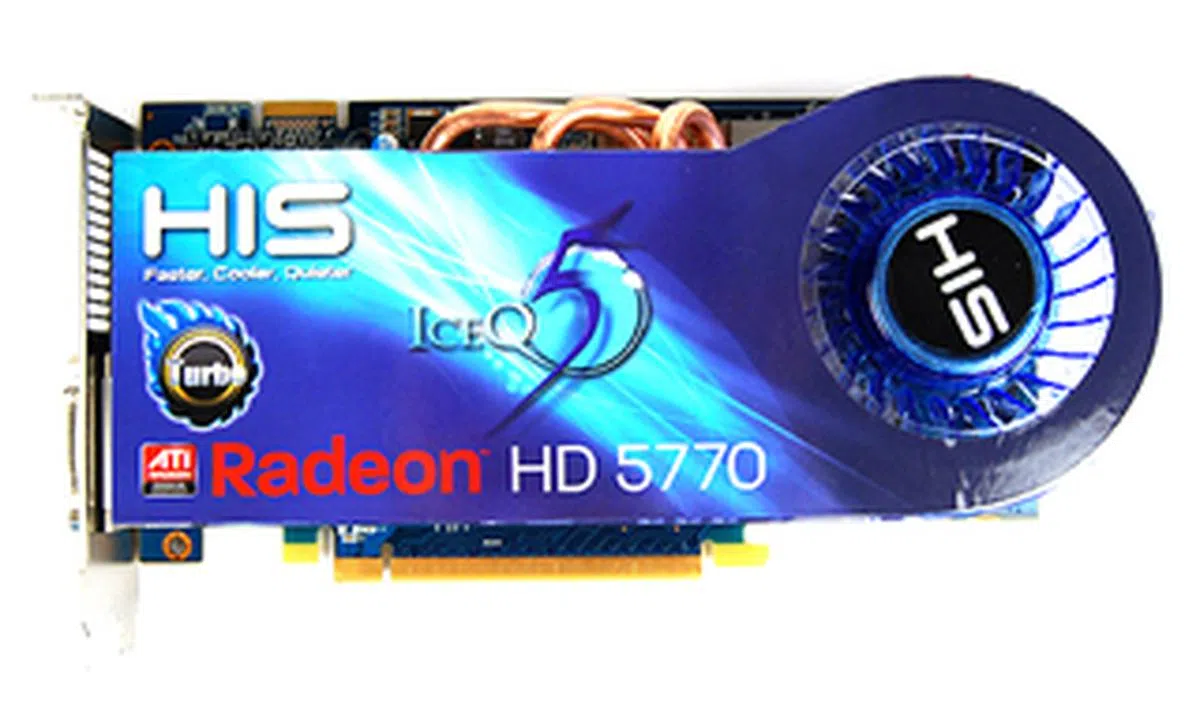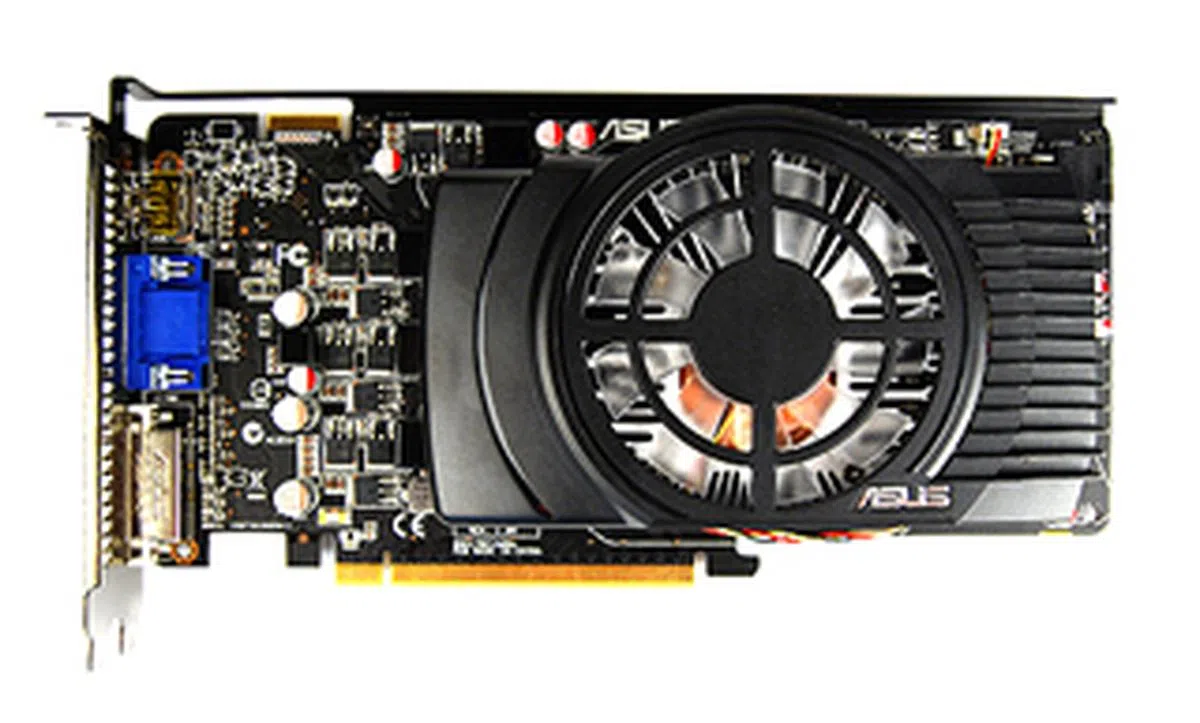Radeon HD 5770 Roundup - ASUS vs. Gigabyte vs. HIS
The Radeon HD 5770 is the weapon of choice for those seeking a powerful yet relatively affordable DirectX 11 graphics card. We check out customized versions from ASUS, Gigabyte and HIS.
By Kenny Yeo -
Revisiting the Radeon HD 5770
The Radeon HD 5770 SKU is perhaps one of the least exciting amongst ATI's lineup of Evergreen graphics cards. Perhaps overshadowed by its more impressive Radeon HD 5870 and HD 5850 siblings, the Radeon HD 5770 does not provide the leap in performance we were expecting.
Powered by the Juniper XT chip, its stream processor count and GPU sub-function unit numbers are identical to the older Radeon HD 4870. This means 800 stream processors, 40 texture mapping units and 16 raster operating units. However, it makes do with a narrower 128-bit memory bus - the Radeon HD 4870's is 256-bit wide. To compensate, the Radeon HD 5770 has higher clock speeds than the Radeon HD 4870; it's 100MHz faster at the core (850MHz) and a full 1200MHz DDR quicker at the memory subsystem (4800MHz DDR). Despite these revisions, stock-to-stock, a reference Radeon HD 5770 is only about as quick as its older Radeon HD 4870 predecessor, and loses out slightly to the Radeon HD 4890. So the performance expectations are a little disappointing when one generally expects improvements with newer gear.
Nevertheless, the new Juniper XT chip does bring about improvements such as support for DirectX 11, EyeFinity, and much lower operating temperatures and power draw. These are reasons enough for an upgrade for those who needed performance characteristics of the 4800 series but with the improved characteristics of the 5700 series.

Clockwise from top left: Gigabyte HD 5770 Super Overclock, HIS HD 5770 IceQ 5 Turbo and ASUS EAH5770 CuCore.
To further improve upon the Radeon HD 5770, vendors have been coming up with their own customized versions, which gives the Radeon HD 5770 SKU much needed pizzazz. Earlier, we have reviewed two customized Radeon HD 5770 cards from MSI and PowerColor, and today, we turn our attention to another three more contenders - ASUS, Gigabyte and HIS.
The ASUS EAH5770 CuCore
Our first contender is the ASUS EAH5770 CuCore. As its name suggests, the card uses copper extensively in its custom-design cooler. As the photos below show, the core of the cooler heatsink is a big block of copper, which is in turn surrounded by an elaborate aluminum heatsink. ASUS says such a design will allow heat to be transferred quicker from the GPU core to the heatsink, resulting in lower operating temperatures.
While the cooler's design seem sound, in theory at least, the specifications of the card disappoint mainly because it retains ATI's reference clock speeds, which means 850MHz at the core and 4800MHz DDR. Here's a reference card from PowerColor to measure up against the ASUS card:-

The ASUS EAH5770 CuCore looks distinctly different from a reference card thanks to its customized CuCore cooler.

For video output, users can choose from a single DVI, HDMI or DisplayPort.

Removing the cooler, we can clearly see the copper core that forms the heart of the card's customized cooler.
The Gigabyte HD 5770 Super Overclock
Bolstering Gigabyte's latest Super Overclock line of customized and overclocked graphics cards is the HD 5770 Super Overclock. This card stands out from the rest mainly because of its clock speeds, 900MHz at the core and 4800MHz DDR, which happens to be the highest of trio.
What's also interesting is that chips that go into making the HD 5770 Super Overclock are cherry-picked using a process Gigabyte calls “GPU Gauntlet”. According to Gigabyte, it is a stringent selection process where each chip is specifically selected to offer not only the highest overclocking performance, but also highest level of power efficiency.
That aside, the card also gets the Ultra Durable VGA label that signifies quality components being used. And this includes additional copper in the PCB for better power and thermal efficiency, top-quality memory chips from Samsung/Hynix, Japanese-made solid capacitors and ferrite core based chokes.

The Gigabyte HD 5770 Super Overclock has a custom cooler that employs a larger fan as well as four thick copper heat pipes.

Similar to a reference card, the Gigabyte HD 5770 Super Overclock has two DVI ports, a single HDMI port and a lone DisplayPort.

Here we can clearly see the four thick copper heat pipes sprouting from the heatsink core. The heat pipes help spread heat evenly to various parts of the heatsink for better heat dissipation.
The HIS HD 5770 IceQ 5 Turbo
HIS' revered IceQ cooler makes its comeback in the company's latest Radeon HD 5770 card. Already in its fifth edition, the IceQ 5 cooler on this card looks remarkably similar to older IceQ coolers we've seen. However, HIS states that minor tweaks have been made to make the card run cooler.
And as the “Turbo” in the name indicates, the card comes factory-overclocked - 875MHz at the core and 4800MHz DDR at the memory. It's not as aggressive as the Gigabyte HD 5770 Super Overclock, but we should see some improvement in performance over a bone stock reference Radeon HD 5770 and the ASUS EAH5770 CuCore.

The HIS HD 5770 IceQ 5 Turbo looks very much like any other HIS card employing their unique IceQ coolers.

Video output options are similar to the Gigabyte card - two DVI ports and a single HDMI and DisplayPort.

Again, we see the use of triple copper heat pipes to quickly draw away from the GPU core and to spread it to other parts of the heatsink.
Test Setup
The cards will be tested using our high-end X58 system with the following specifications:
- Intel Core i7-975 (3.33GHz)
- Gigabyte GA-EX58-UD4P motherboard
- 3 x 1GB DDR3-1333 OCZ memory in triple channel mode
- Seagate 7200.10 200GB SATA hard drive
- Windows 7 Ultimate
If clock speeds are any accurate indication of performance, then we expect to see the aggressively overclocked Gigabyte HD 5770 Super Overclock to come out tops amongst the trio, followed by the HIS HD 5770 IceQ 5 Turbo and then the ASUS EAH5770 CuCore. Even so, expect performance to be really competitive since the difference in core clock speeds is only a maximum of 50MHz. That aside, all cards have 1GB of GDDR5 memory which are all running at the same 4800MHz DDR.
Raw performance aside, we are also interested in seeing how their custom-designed coolers would perform, and how much overclocking overhead we can achieve. We've also included results from the GeForce GTX 260+ for comparison.
The list of cards tested and their driver versions:
- ASUS EAH5570 CuCore (Catalyst 10.5)
- Gigabyte HD 5770 Super Overclock (Catalyst 10.5)
- HIS HD 5770 IceQ 5 Turbo (Catalyst 10.5)
- Reference ATI Radeon HD 5770 (Catalyst 10.5)
- NVIDIA GeForce GTX 470 (ForceWare 197.41)
- NVIDIA GeForce GTX 260+ (ForceWare 197.45)
The list of benchmark used are as follows:
- Futuremark 3DMark Vantage
- Crysis Warhead
- Far Cry 2
- Warhammer: Dawn of War 2
- Battlefield Bad Company 2
- "Heaven" from Unigine
- S.T.A.L.K.E.R.: Call of Pripyat
3DMark Vantage Results
As we've anticipated, our trio of Radeon HD 5770 was very competitive on 3DMark Vantage. However, the overclocked duo of Gigabyte and HIS scored slightly higher than the ASUS card, which has reference clock speeds. Also, we can see that the Radeon HD 5770 is a good match for the older NVIDIA GeForce GTX 260.

Crysis Warhead & Far Cry 2 Results
Again, the three non-reference Radeon HD 5770 posted scores that were evenly matched. The odd thing was, despite the Gigabyte's card higher clock speeds, we noticed that it was consistently outperformed by the lower clocked HIS HD 5770 IceQ 5 Turbo. The difference wasn't much of course, but it is something worth taking note of.


On Far Cry 2, it was more of the same. Even with its higher clock speeds, both the Gigabyte and HIS cards were unable to post a convincing lead over the ASUS card and a reference Radeon HD 5770. To end, the NVIDIA GeForce GTX 260 was by far the quickest card and not surprising too with its wider memory bus and more processing power.


Dawn of War 2 & Battlefield Bad Company 2 Results
On Dawn of War 2, the two overclocked Radeon HD 5770 cards from Gigabyte and HIS managed noticeably higher frame rates, but it was still a tightly contested affair as the difference was about 4% at most. Also, the higher clocked Gigabyte HD 5770 Super Overclock was still unable to consistently outperform its HIS rival.

On Bad Company 2, we can see two distinct tiers of performance. Sporting identical clock speeds, the ASUS EAH5770 CuCore and the reference Radeon HD 5770 was slightly slower compared to the two overclocked cards from Gigabyte and HIS.

Unigine "Heaven" Results
The results on Unigine's “Heaven” benchmark mirrors that of Bad Company 2, where there's two noticeable tiers of performance. Naturally, the ASUS EAH5770 CuCore and the reference Radeon HD 5770 was slower, but like in previous benchmarks, the difference wasn't much. And once more, the Gigabyte HD 5770 Super Overclock failed to garner any significant lead over the HIS HD 5770 IceQ 5 Turbo.
DirectX 11 Results


DirectX 10 Results


S.T.A.L.K.E.R.: Call of Pripyat Results
Results from S.T.A.L.K.E.R.: Call of Pripyat yielded the same findings as our previous two benchmarks. While the overclocked duo of Gigabyte and HIS were quicker, the difference was, once again, minimal – around 3%. On the DirectX 10 runs, we noticed also that the NVIDIA GeForce GTX 260 was still competitive against the newer Radeon HD 5770, easily outscoring them on the “Day” run. However, performance suffered greatly when it came to the more taxing “Sunshafts” run.
DirectX 11 Results
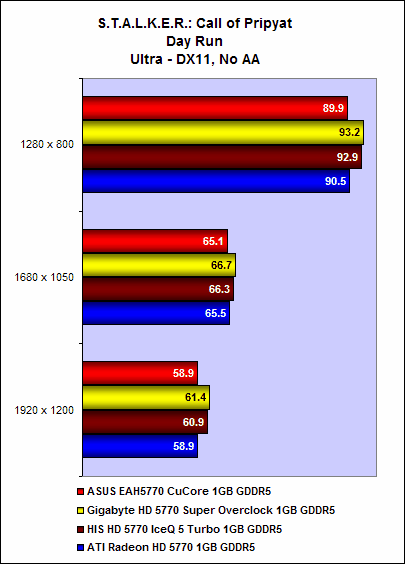 | 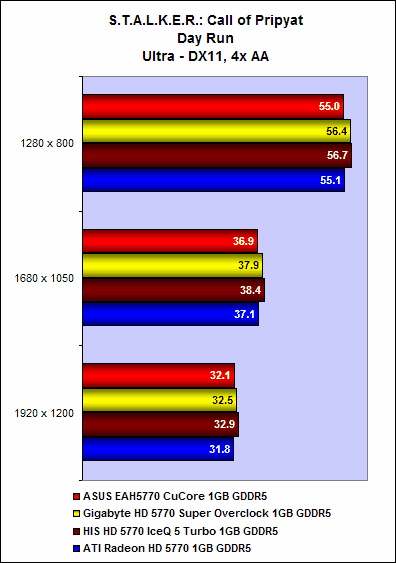 |
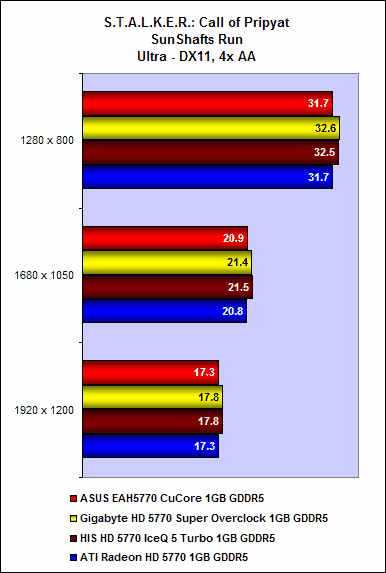 | 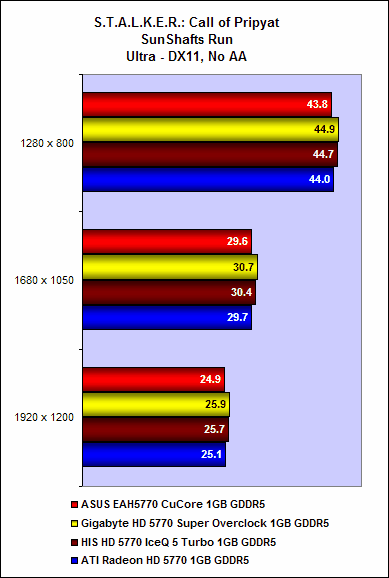 |
DirectX 10 Results
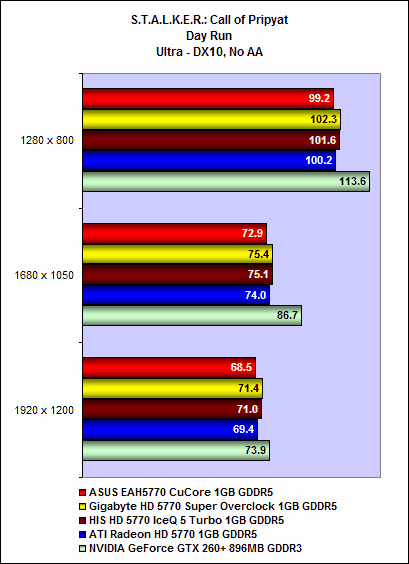 | 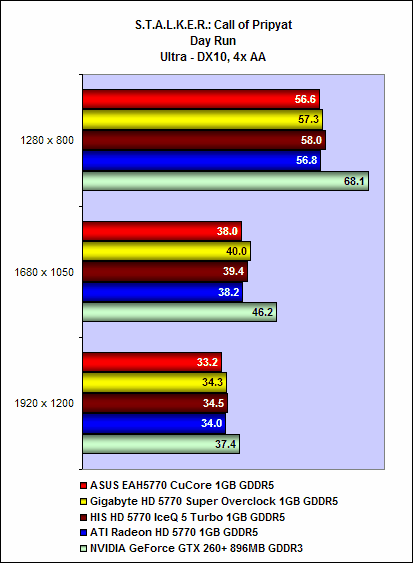 |
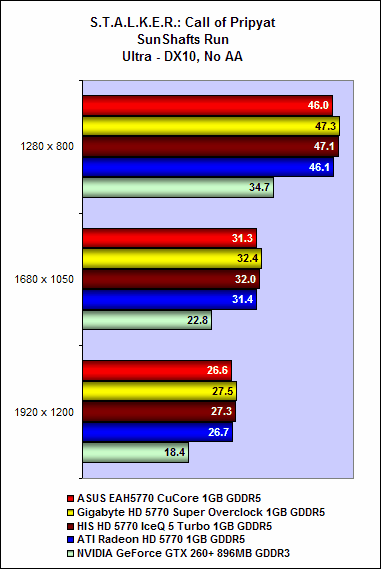 | 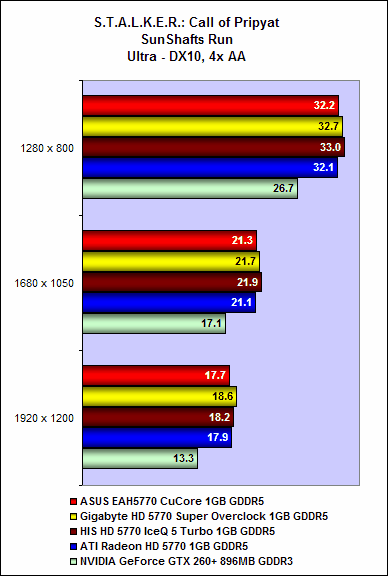 |
Temperature
Where raw graphics performance was concerned, the cards were mostly evenly matched, but when it came to the effectiveness of their custom coolers, there was a clear winner. The Gigabyte HD 5770 Super Overclock recorded a maximum operating temperature of a cool 60 degrees Celsius, which represents a significant 8 degrees Celsius improvement over ATI's reference design.
On the other hand, it was disappointing to see the ASUS card with its special CuCore cooler and the HIS card with its IceQ 5 cooler, recording around 70 degrees Celsius, which meant the cooler didn't do much to improve on ATI's original design.

Power Consumption
Power consumption readings from our trio of cards matches up to that of a reference one, although it must be said that their readings at load were a tad higher. Our reference card recorded 177W at load, whereas the custom-design cards all recorded around 185W to 191W. And although the GeForce GTX 260 was competitive, its power draw was easily the highest.

Overclocking
While the Gigabyte HD 5770 Super Overclock failed to convincingly outperform its lower clocked rival, the HIS HD 5770 IceQ 5 Turbo on stock performance, it did well on our overclocking tests, as we successfully got it to run stably at 970MHz at the core and at a nearly unbelievably 5500MHz DDR at the memory. This gave us 5356 3DMarks on the Extreme preset. To be fair, the HIS and ASUS cards weren't too far behind.

No Clear Winner
Although the trio of custom-designed cards performed commendably, they failed to add anything new or exciting to the Radeon HD 5770 SKU that we haven't already seen in our previous review of the MSI R5770 Hawk and PowerColor PCS+ 5770. Before we continue, here's a summary of the card's clock speeds and price:
Card | Core Clock speed | Memory Clock speed | Price |
ASUSEAH5770 CuCore | 850MHz | 4800MHz DDR | US$169 |
Gigabyte HD 5770 Super Overclock | 900MHz | 4800MHz DDR | US$179 |
HISHD5770 IceQ 5 Turbo | 875MHz | 4800MHz DDR | US$169 |
With the ASUS EAH5770 CuCore being the lone exception due to its reference clock speeds, both the HIS HD 5770 IceQ 5 Turbo and Gigabyte HD 5770 Super Overclock performed as they should, thanks to their higher clock speeds.
The odd thing, however, is that the Gigabyte card failed to command any significant or noticeable lead over the HIS card. Perhaps this is due to the narrow 128-bit memory interface that the Juniper XT chip has to make do with, making any improvements to core clock speeds redundant if not paired with an increase in memory clock speeds as well.
Moving on, we must praise the cards for their eagerness to overclock. We managed to get all three cards to run at clock speeds substantially higher than stock, and even the 'worst' performing card – the ASUS EAH5770 CuCore – managed 960MHz at the core and 5400MHz DDR at the memory, which is simply astounding considering a stock card sports clock speeds of only 850MHz and 4800MHz DDR.
What we aren't too happy with, however, is the effectiveness of the custom coolers. Apart from the Gigabyte HD 5770 Super Overclock, both ASUS' and HIS' coolers failed to record any significant improvement over ATI's reference design. Perhaps ATI's reference cooler isn't so bad after all, nevertheless, we expected to see at least some improvement.
Of the trio, the Gigabyte HD 5770 Super Overclock is our pick of the lot. Not only it is faster than a reference Radeon HD 5770, it also runs cooler as well. All in all, it's an improvement over a bone stock Radeon HD 5770.
The HIS Radeon HD 5770 IceQ 5 Turbo is a close second, because while it is faster than a reference card, its cooler failed to live up to our expectations. But if its any consolation, the HIS card is a tad cheaper than the Gigabyte one, so all things considered, its a slightly less capable card compared to the Gigabyte.
Finally, the ASUS EAH5770 CuCore is a little disappointing. Not only because it has reference clock speeds and hence performed identically to a reference card, but also because its fancy CuCore cooler failed to achieve lower operating temperatures than a stock cooler. If it's any consolation, it is a keen overclocker (luck plays a big part though), and at US$169, it costs only about US$10 more than reference versions.
| |
|  |
|  |
Our articles may contain affiliate links. If you buy through these links, we may earn a small commission.
